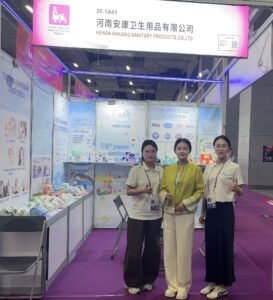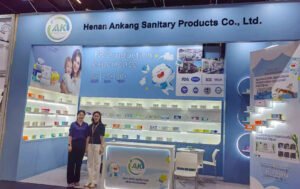Introduction: Why Ingredient Choice Matters More Than You Think
Have you ever wondered why some baby wipes leave your little one’s skin irritated, while others feel like a gentle hug? Ankang wet wipes manufacturer will tell you the secret lies in the ingredients. Your baby’s skin is 30% thinner than yours, making it vulnerable to harsh chemicals and allergens. Choosing the right components isn’t just about cleanliness—it’s about nurturing delicate skin and preventing rashes, dryness, or long-term sensitivities. Let’s dive into the science, ethics, and practicalities behind crafting the perfect baby wipe.
Understanding Baby Skin: The Fragile Canvas
Imagine baby skin as a freshly bloomed rose petal—soft, porous, and exquisitely sensitive. Unlike adult skin, it lacks a robust moisture barrier, making it prone to dehydration and irritation. This is why pH balance, hypoallergenic properties, and moisture retention are non-negotiable in ingredient selection.
At Ankang wet wipes factory, we start with one rule: If it’s not safe enough to eat (metaphorically speaking!), it doesn’t belong in a wipe. While that’s an oversimplification, it underscores the need for rigorously tested, skin-friendly components.
Key Ingredients to Look For in Baby Wipes
1. Water: The Foundation of Purity
Surprised? Many parents are. Water comprises 90–95% of most baby wipes, but not all water is equal. We use purified water (often labeled as “aqua” or “eau”) to eliminate minerals, bacteria, and impurities. Think of it as the “blank canvas” that ensures other ingredients work effectively without contamination.
2. Mild Surfactants: Gentle Cleansing Agents
Surfactants lift dirt and oils, but harsh variants like sodium lauryl sulfate (SLS) can strip natural oils. Opt for wipes with cocamidopropyl betaine or decyl glucoside—plant-derived cleansers that foam gently without irritation.
3. Humectants: Locking in Moisture
Babies’ skin loses moisture rapidly. Ingredients like glycerin (vegetable-based) or pro-vitamin B5 act like magnets for hydration, creating a protective barrier.
4. Soothing Botanicals: Nature’s First Aid Kit
Chamomile, calendula, and aloe vera aren’t just marketing buzzwords. These botanicals have anti-inflammatory properties proven to calm redness. For example, aloe vera contains polysaccharides that accelerate skin repair—ideal for diaper rash.
5. pH-Balanced Formulas: Mimicking Nature
Healthy baby skin has a pH of 5.5–6.5. Wipes with a similar pH (look for “pH-balanced” labels) maintain this acidity, discouraging harmful bacteria while preserving the skin’s microbiome.

Red Flags: Ingredients to Avoid at All Costs
1. Alcohols (Ethanol, Isopropyl Alcohol)
Alcohols are drying agents that disrupt the skin barrier. Imagine pouring rubbing alcohol on a paper cut—that’s what ethanol does to microtears in baby skin.
2. Parabens and Phenoxyethanol
These preservatives prevent bacterial growth but are linked to hormone disruption and allergies. Safer alternatives include sorbic acid or potassium sorbate.
3. Synthetic Fragrances
A “fresh linen” scent might appeal to parents, but synthetic fragrances are a cocktail of undisclosed chemicals. Over 3,000 compounds fall under this term, many of which trigger contact dermatitis.
4. Methylisothiazolinone (MI/MIT)
This preservative has caused an epidemic of allergic reactions in Europe and the U.S. The American Contact Dermatitis Society named it “Allergen of the Year” in 2013—hardly an accolade you want in your wipes!
Certifications: Your Shortcut to Trust
How can busy parents decode ingredient lists? Look for certifications:
- ECARF (European Centre for Allergy Research Foundation): Guarantees hypoallergenic standards.
- FSC (Forest Stewardship Council): Ensures sustainable wood pulp for biodegradable wipes.
- Dermatologically Tested: Indicates independent lab testing for irritation.
At Ankang wet wipes factory, we pursue these certifications not for marketing clout but because they align with our ethos: transparency over profit.
The Eco Dilemma: Biodegradable vs. Effectiveness
Can a wipe be both planet-friendly and tough on messes? Yes—if you prioritize plant-based fibers (like bamboo or cotton) and avoid plastics like polyester. However, some “biodegradable” wipes dissolve too quickly, leaving parents with a handful of pulp. Balance is key: our R&D team spent 18 months perfecting a blend of wood pulp and lyocell that holds up under pressure (literally!).
Fragrance-Free vs. Unscented: Know the Difference
- Fragrance-Free: No added masking scents, though natural ingredients may have mild odors.
- Unscented: Often contains synthetic neutralizers to mask smells.
When in doubt, choose fragrance-free. Your baby’s skin doesn’t need to smell like a meadow—just be clean and healthy.
The Role of Packaging: Preserving Integrity
Ever opened a wipe pack to find dry, brittle sheets? Blame poor packaging. Ingredients degrade when exposed to air, so opt for double-sealed packs or resalable flaps. We use food-grade polyethylene liners to lock in moisture without leaching harmful microplastics.
Final Thoughts: Empowerment Through Knowledge
Choosing baby wipes isn’t about finding the cheapest or prettiest pack—it’s about vetting what touches your child’s skin 10+ times a day. As manufacturers, we bear the responsibility to prioritize safety over shortcuts. Your job? Become a label detective. Scan for certifications, avoid red-flag ingredients, and trust your instincts. After all, if a wipe’s ingredient list reads like a chemistry textbook, it’s probably not the best choice.
FAQs
1. Are “natural” wipes always safer?
Not necessarily. “Natural” isn’t a regulated term. Some plant extracts (e.g., citrus oils) can irritate skin. Focus on certifications like ECOCERT or USDA Organic instead.
2. Can baby wipes cause allergies?
Yes, particularly if they contain fragrances or MIT. Patch-test new wipes on a small area of your baby’s arm before full use.
3. How do I know if a wipe is pH-balanced?
Check the label—reputable brands advertise this prominently. You can also email the manufacturer for test results.
4. Are biodegradable wipes less effective?
Not inherently. High-quality biodegradable materials (e.g., bamboo) are durable and effective when engineered correctly.
5. How long can I use an opened pack of wipes?
Most preservatives last 1–2 months after opening. Store packs upright, seal tightly, and avoid high humidity.





